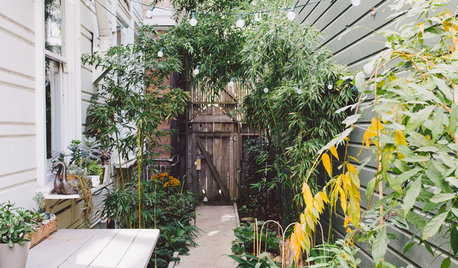Any advice on making tomato cages?
throgmorten
18 years ago
Related Stories

EDIBLE GARDENSSummer Crops: How to Grow Tomatoes
Plant tomato seedlings in spring for one of the best tastes of summer, fresh from your backyard
Full Story
FARM YOUR YARDAdvice on Canyon Farming From L.A.'s Vegetable Whisperer
See how a screened garden house and raised beds help an edible garden in a Los Angeles canyon thrive
Full Story
HEALTHY HOMEHow to Childproof Your Home: Expert Advice
Safety strategies, Part 1: Get the lowdown from the pros on which areas of the home need locks, lids, gates and more
Full Story
FEEL-GOOD HOMESimple Pleasures: Make Do and Mend
Experience the satisfaction of fixing, repurposing and creating things yourself around the home
Full Story
MOST POPULAR8 Little Remodeling Touches That Make a Big Difference
Make your life easier while making your home nicer, with these design details you'll really appreciate
Full Story
VACATION HOMESMake Your Vacation Home Pay Off
Renting your vacation house when you're not using it makes good financial sense. These tips can help
Full Story
GARDENING AND LANDSCAPING10 Ways to Make the Most of Your Side Yard
Don’t overlook the possibilities for this often-forgotten space
Full Story
LIFEHow to Make Your House a Haven Without Changing a Thing
Hung up on 'perfect' aesthetics? You may be missing out on what gives a home real meaning
Full Story
KITCHEN DESIGNKitchen of the Week: Making Over a Rental for About $1,500
Fresh paint, new hardware, added storage, rugs and unexpected touches breathe new life into a Los Angeles apartment’s kitchen
Full Story
TILESource List: 20 Tiles That Make a Statement
Learn about the tiles that make these popular rooms stand out
Full Story





ruthieg__tx
jimm_sc
Related Professionals
Maple Valley Landscape Architects & Landscape Designers · East Rancho Dominguez Landscape Architects & Landscape Designers · Sand Springs Landscape Architects & Landscape Designers · Braintree Landscape Contractors · Dunwoody Landscape Contractors · Flagstaff Landscape Contractors · Kahului Landscape Contractors · Kettering Landscape Contractors · Mason Landscape Contractors · West Orange Landscape Contractors · 07920 Landscape Contractors · Northlake Landscape Contractors · Kenosha Siding & Exteriors · Puyallup Siding & Exteriors · Worcester Siding & Exteriorsjenica
iliketoplayinthedirt
chickachee
led_zep_rules
jacob_mm
toomanypotatoes
spiced_ham
wally_1936
iam3killerbs
novice_2009
iam3killerbs
megmaine
marty_muhnberger_com